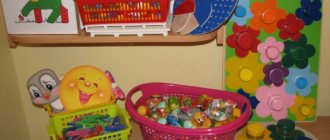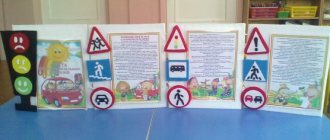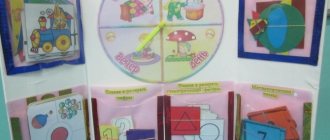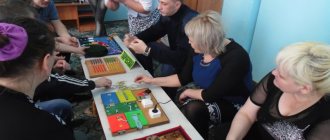Robots Education Creativity
Details Published: 02/15/2016 09:01 Author: Yulia Aleksandrovna Fedorova, teacher at the kindergarten No. 305, Perm
The duration of the lesson is 20-25 minutes.
Goal: creation and testing of the “Carousel” model.
Tasks:
|
Progress of the lesson.
Introductory part (2-3 minutes): Children enter the computer class. On the table there is a model of an amusement park, in the center of which are Masha and Max. — Guys, Masha and Max went for a walk. Please tell me where they ended up? - To the amusement park. - Why do you think our friends are so sad? “They didn’t have enough attractions.” — What attraction is missing in the park? - Carousels. — Guys, let's build a carousel for Masha and Max from our Lego constructor.
Main part (15 minutes): - I invite you to see what kind of carousel we have to build today (children go to their chairs, the presentation starts).
— Did you know that the first carousels appeared a long time ago and were used by riders for training. In Russia, the first carousel for children appeared about 120 years ago and it was made of wood. And today we will build such a carousel with you (the presentation includes watching a video demonstrating the operation of the assembled model of the carousel). But before we get started, we'll stretch our fingers.
Finger gymnastics
| We will please our friends and build a carousel. And so that troubles do not happen, We have one secret: We will assemble any model, If we work together together! | They clench and unclench their fists, strike their fists against each other, clench and unclench their fists, bring their index finger to their mouth, strike their fists against each other, lock their fingers together |
Children are divided into pairs and assemble a model at the computer according to the instructions provided. The teacher controls the assembly process and helps the children if necessary.
- Guys, I see that you all successfully completed the task and were able to assemble a model of the carousel. Before testing the model, I suggest you do a warm-up.
Physical education moment
| It is impossible to live without technology in our lives, and we, roboticists, come to everyone’s aid. We worked hard, there will be a carousel in the park, We will conduct tests and give everyone a ride on it! | Perform a spring March in place Perform bends Rotate the arms in front of the chest |
— Before installing our carousels in the park, it is necessary to conduct tests. Today I suggest you use my program (the program is displayed on the board using a projector).
Children create a program on their computers. Connect the model to the computer and check the operation of the carousel.
Final part (3-5 minutes).
- Guys, you did a great job, all the models successfully passed the tests, so now we can install them in the park and please our friends (the children install the carousels in the park, seat Masha and Max on them).
- Now our friends are happy and as a farewell I invite you to take a ride on our carousel.
Game "Carousel"
Children take the hoop with their hands and, together with the teacher, repeat the words, simultaneously moving in a circle:
Barely, barely, barely, The carousels began to spin, And then, then, then, Everyone ran, ran, ran. Hush, hush, don't rush, Stop the carousel, One-two, one-two, The game is over.
{jcomments on}
Didactic game for speech development “Carousel, Carousel”
Didactic game for speech development for preschool children (4–7 years old) “Carousel, Carousel”
Author:
Maslyukova Oksana Aleksandrovna,
teacher,
MADOU kindergarten No. 36, Tyumen
first category
Purpose of the game: to form the sound culture of speech, grammatical structure, coherent speech, and expand the vocabulary of preschoolers.
Didactic material: carousel, set of vowel and consonant sounds, sets of subject pictures (clothing, toys, vegetables, food, dishes, domestic and wild animals, school supplies), chips.
Tasks:
1) teach children to find a given sound in a word at the stage of loud pronunciation of the word by the child himself;
2) teach how to assign individual items to certain thematic groups;
3) exercise children in selecting words with a certain sound;
4) develop phonemic awareness, teach the correct pronunciation of certain sounds in words, help them pronounce words with these sounds clearly and clearly;
5) expand and deepen children’s understanding of wild and domestic animals;
6) activate children's vocabulary.
Publication by the author in 2014:
https://www.maam.ru/detskijsad/-karusel-karusel-didakticheskaja-igra-po-razvitiyu-rechi-dlja-detei-doshkolnogo-vozrasta-4-7-let-218158.html
Progress of the game.
1. “I choose.”
6 people play. The cards lie face down on the table. Everyone takes one picture, names its generic concept, to which this picture belongs, and inserts it into the pocket of the upper tier. In this way, it is established which group each participant will assemble. If identical groups are selected, one more picture is opened. Then the presenter shows the players one picture at a time, and they must ask for one or another picture: “I choose a doll, because I collect toys,” and places it on the appropriate field. The first one to collect his group of pictures wins. (The number of pictures in each group is the same).
2. “Pronounce correctly and identify the sound.”
6 children playing. The presenter places vowel sounds (consonants) in a pocket on the top tier and distributes the same number of pictures to the children, names any vowel (consonant) sound, the children take turns saying the names of their pictures out loud and finding the ones they need. If the picture is named correctly, the presenter allows it to be placed on the bottom tier of the carousel of the same color where the named sound is located. If by the end of the game some children still have pictures, the presenter offers to name them and determine where the sound is. The first one to arrange all the pictures correctly wins.
3. “Call me kindly.”
Pictures of the choice of the presenter (children) are placed in the pockets of the upper tier. Children receive chips of the same color and choose a field. The presenter suggests: “How can you call it affectionately?” Children call in turns and for each affectionate word they say, they put a chip. The one who earns more chips, that is, says more words, wins.
4. “Who can name the most actions?”
Pictures depicting an airplane, cat, car, etc. are placed in the pockets of the upper tier. Children are asked to name as many actions as possible that this object can perform. For example, an airplane takes off (landes, flies, buzzes, lands, refuel, etc.). Children take turns calling action words and placing a chip of their color. If one of the children cannot say more words, you can help him and put his chip on the field. The one who places the most chips wins.
5. “Take a ride on the carousel.”
Option 1. From 2 to 10 children play. They are asked to guess the animal from the description. For example: this is an animal... It lives in a human household. It has the following structure: 4 legs with hooves, a short tail, a small body covered with gray, white, red or black hair, an udder with two nipples, horns and a beard on its head, and large eyes. This animal eats grass, hay, and vegetables. It gives milk. This... A child who guesses the animal can ride it on the carousel.
Option 2. At the request of the children, the child himself describes any domestic (wild) animal. The child who guesses correctly takes the animal on a carousel.
The games are easy to organize and designed for individual and group work with children and independent activities.
Dear teachers and parents - participants of the exhibition!
On June 2, 2015, a solemn ceremony of awarding the winners of the regional methodological exhibition “Modern educational environment of kindergarten and family” took place at the information and exhibition complex of the Tyumen Regional Duma. Details >>>
From June 8 to June 10, 2015, teachers from Tyumen received certificates of exhibition participants and multimedia albums with the full version of the exhibition at the Grant Center for the Development of Creativity for Children and Youth at the address: Profsoyuznaya St., 52. tel. for inquiries: 685-321,
June 9, 2015 Diplomas, certificates and gifts were sent to the winners and participants of the Exhibition of the south of the Tyumen region, Yamal-Nenets Autonomous Okrug and Khanty-Mansi Autonomous Okrug-Yugra by registered parcel post to the address of the preschool educational institution. Details >>>
Share
Physical education entertainment in kindergarten and senior group. Outdoor games fair
Synopsis of physical education “Fair of outdoor games” for children 5-6 years old
Description of the material: I offer you a synopsis of physical education “Fair of outdoor games” for children of the older group. The material will be useful to teachers of senior groups, physical education instructors, and additional education teachers. This summary is aimed at cultivating interest in folk games, traditions, developing a responsive, friendly attitude towards others, and also contributes to the accumulation of motor experience in preschoolers 5-6 years old. Integration of educational areas: “Physical education”, “Cognition”, “Communication”. Goal: To develop children’s interest in physical education and to promote harmonious physical development. Objectives: Educational:
Accumulation and enrichment of children’s motor experience, to consolidate children’s ideas about Russian folk games and traditions.
Developmental:
Improve children's motor skills.
Develop the ability to maintain correct posture, promote the development of respiratory muscles, and maintain a positive emotional tone. Educational:
Continue to improve children's health through outdoor games.
Cultivate endurance, attention, and ingenuity. Develop agility, evasiveness in running, and the ability to act on a signal. Benefits: Game cube with pictures, rope, step steps, masks, balloons. Methodological techniques: questions to children, signals, poems, competitive exercises, verbal instructions, fun games, outdoor games.
Move
Presenter: The sun is rising brightly, people are rushing to the fair. The gates are opening, come in, gentlemen! to the accompaniment of Russian folk music, children enter the hall. Presenter: Our fair is not simple, it is not like any other fair in the world. This is a fair of outdoor games. Today I invite you to play Russian folk games and have fun. I invite you to a game, I’ll start a carousel. Outdoor game “Carousel” Presenter: I have this painted Miracle cube. You throw it quickly and choose a game. The presenter gives the child a cube, and he throws it. Whichever picture he stops at, that game is played. Game “Bears and Bees” (climbing a gymnastic ladder). Game “Frogs in the Swamp” (jumping from an object). Presenter: Songs, games, round dances will not go out of fashion. Get ready, kids, since it’s time to play! Outdoor game “Owl” (running) Presenter: We are not too lazy to play and sing, We would dance all day long! Musical break “Russian dance” Presenter: We danced, just great! Let's throw the dice now. Outdoor game “Cat and Mice” Presenter: What happened at the fair were merchants with various goods, funny buffoons with games and dances, horseback riding with bells and, of course, wandering musicians and circus performers. With surprise and admiration, people watched how deftly the tightrope walkers walked at great heights. It seemed incredible to slide so gracefully and easily along thin ropes. And at our fair we have people who walk on ropes. They keep the bags on their heads and don’t fall off. The game is fun “Rope walkers” (balance) Host: Yes, what dexterous and skillful guys you are. Well done! Keep your balance like real tightrope walkers. What is this left in my bag? Oh, I almost forgot, the most important thing. After all, at the fair it’s time to measure strength - pull the rope. Well, come out! Let's see who is stronger. Tug of war. Presenter: Good fellows, red maidens For fun, for the game Multi-colored balls! Game - fun with balloons Presenter: The hour of farewell is coming. I tell you: “Goodbye!” Until pleasant new meetings This is the end of the fair! Who played, well done!
We recommend watching:
Physical education in the senior group. Scenario Scenario of New Year's physical education entertainment together with parents of children of the senior group Scenario of physical education entertainment together with parents of children of the senior group Summary of physical education entertainment in the senior group of compensatory orientation
Similar articles:
Physical education leisure in the senior group in kindergarten “Journey to the Land of Health”
Entertainment based on the fairy tale “Kolobok”, 2nd junior group





